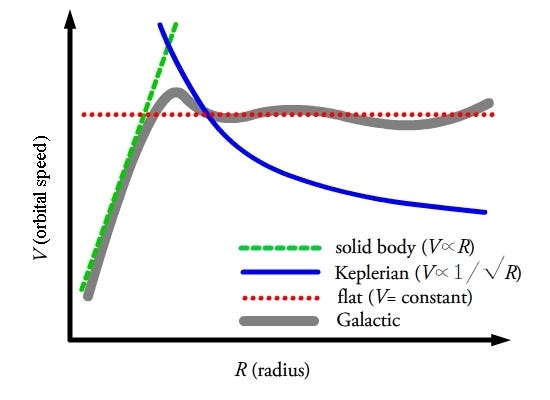The Enigmatic Nature of Dark Matter: What Lies Beyond Our Sight
Written on
Chapter 1: Understanding Dark Matter
Dark matter stands as one of the most captivating subjects in contemporary fundamental physics, and for valid reasons. Essentially, it holds the promise of unveiling profound insights into the basic principles governing reality by bridging the vast phenomena we observe in the universe with the minute particles that compose it. Despite its theoretical nature, dark matter has yet to be directly observed. What leads us to believe in its existence? What form might it take? Is it tangible, and if so, what would it taste like? Let’s delve deeper into these intriguing questions.
Section 1.1: The Case for Dark Matter
The notion of dark matter may strike you as a recent, speculative idea; however, evidence for unobservable matter dates back to 1933, during a time when even the Big Bang theory was hotly debated. Swiss astronomer Fritz Zwicky, utilizing the Virial theorem—which focuses on kinetic energy—determined that a particular galaxy cluster harbored more mass than what was predicted based on its luminosity. Since then, numerous systems in the universe have exhibited behaviors that contradict our current gravitational theories, particularly General Relativity. We have compelling observational evidence supporting dark matter’s existence, including phenomena like gravitational lensing, large-scale structures, and galaxy dynamics. One of the most striking enigmas is the galactic rotation curve.
In simple terms, classical physics, including Kepler’s laws, suggests that stars further from the galactic center should orbit more slowly. However, observational data reveals that stars maintain similar velocities irrespective of their distance from the center. Why is this discrepancy present? The answer remains elusive.

Section 1.2: Why Dark Matter Is Essential
A thought-provoking quote states:
"Physicists claiming dark matter exists is akin to saying 1 + 1 = 3 due to an unseen dark number."
At first glance, this seems to resonate with many who argue that our gravitational theories may not have the final say. Indeed, this perspective holds some merit. However, consider the contrary viewpoint: substantial evidence suggests our theories adequately explain most phenomena in the observable universe. Not only have they allowed us to predict the orbits of various astronomical bodies, but they have also led to remarkable predictions about exotic phenomena, such as black holes and time dilation, which have been confirmed through observation. Given our minuscule understanding of the universe, it is plausible that an unknown type of matter could exist, accounting for a significant portion of what we observe.
So, could there indeed be a peculiar form of matter that eludes our detection and constitutes more than a third of the universe? The answer is a resounding yes.
Chapter 2: The Composition of Dark Matter
What is dark matter composed of? The truth is, we don't know.
Section 2.1: The Mystery of Its Composition
Indeed, our understanding is limited, and new theories emerge daily. Historically, it was believed that dark matter particles do not interact with ordinary matter or with each other, likening them to noble gases (the WIMP paradigm). However, this theory has not yielded significant success. An alternative, increasingly favored concept suggests that dark matter particles could interact via a force similar to the strong nuclear force (the SIMP paradigm), potentially allowing them to form bound states akin to atoms. Various other exotic theories exist, but they share a crucial characteristic: dark matter interacts only through gravitational forces with ordinary matter.
In the video titled "Why We Have Not Discovered Dark Matter: A Theorist's Apology," experts delve into the ongoing challenges in detecting dark matter and the theoretical frameworks surrounding it.
Subsection 2.1.1: The Nature of Dark Matter
What does dark matter look like? To answer this, we must first consider what "looking" implies. We perceive objects when electromagnetic radiation reflects off their surfaces and reaches our eyes. Since dark matter does not interact with electromagnetic forces, it is reasonable to conclude that it remains invisible to us.
Section 2.2: The Taste of Dark Matter
If, for some bizarre reason, you were inclined to taste dark matter (which is only conceivable if we assume some clumping behavior), what would you experience? The answer, again, is nothing. Our sense of taste relies on recognizing molecular structures through our taste buds and olfactory senses, which depend on electromagnetic interactions. As dark matter does not engage with these forces, it would leave no flavor or sensation, effectively passing through without a trace.
In the video "What's the Matter with Dark Matter?", viewers explore the fundamental questions and theories regarding the elusive nature of dark matter.
Section 2.3: The Potential for Interaction
Is there a possibility of experiencing dark matter in some capacity? As previously mentioned, dark matter is akin to a masterpiece that we cannot touch or taste. However, gravity provides a unique avenue for interaction.
Imagine being in space near a dense mass of dark matter equivalent to Earth's mass. What sensations would arise as you approached it? Would you simply pass through it? These thought experiments open up fascinating possibilities for understanding dark matter's influence.
Section 2.4: The Location of Dark Matter
Finally, where can dark matter be found? It is believed to exist in a cloud or disc-like formation surrounding galaxies. Is there any on Earth? Most likely not. Why? That remains an intriguing question.